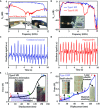Kirigami-Triggered Spoof Plasmonic Interconnects for Radiofrequency Elastronics
- PMID: 38694204
- PMCID: PMC11062506
- DOI: 10.34133/research.0367
Kirigami-Triggered Spoof Plasmonic Interconnects for Radiofrequency Elastronics
Abstract
The flexible and conformal interconnects for electronic systems as a potential signal transmission device have great prospects in body-worn or wearable applications. High-efficiency wave propagation and conformal structure deformation around human body at radio communication are still confronted with huge challenges due to the lack of methods to control the wave propagation and achieve the deformable structure simultaneously. Here, inspired by the kirigami technology, a new paradigm to construct spoof plasmonic interconnects (SPIs) that support radiofrequency (RF) surface plasmonic transmission is proposed, together with high elasticity, strong robustness, and multifunction performance. Leveraging the strong field-confinement characteristic of spoof surface plasmons polaritons, the Type-I SPI opens its high-efficiency transmission band after stretching from a simply connected metallic surface. Meanwhile, the broadband transmission of the kirigami-based SPI exhibits strong robustness and excellent stability undergoing complex deformations, i.e., bending, twisting, and stretching. In addition, the prepared Type-II SPI consisting of 2 different subunit cells can achieve band-stop transmission characteristics, with its center frequency dynamically tunable by stretching the buckled structure. Experimental measurements verify the on-off switching performance in kirigami interconnects triggered by stretching. Overcoming the mechanical limitation of rigid structure with kirigami technology, the designer SPIs exhibit high stretchability through out-of-plane structure deformation. Such kirigami-based interconnects can improve the elastic functionality of wearable RF electronics and offer high compatibility to large body motion in future body network systems.
Copyright © 2024 Xincheng Yao et al.
Conflict of interest statement
Competing interests: The authors declare that they have no competing interests.
Figures




Similar articles
-
Kirigami-Based Highly Stretchable Thin Film Solar Cells That Are Mechanically Stable for More than 1000 Cycles.ACS Nano. 2020 Feb 25;14(2):1560-1568. doi: 10.1021/acsnano.9b06562. Epub 2020 Feb 10. ACS Nano. 2020. PMID: 32023036
-
Bendable transmission line and amplifier of spoof surface plasmon polaritons at microwave frequencies.Opt Express. 2023 Jan 2;31(1):755-764. doi: 10.1364/OE.479642. Opt Express. 2023. PMID: 36607008
-
Kirigami-Inspired Structures for Smart Adhesion.ACS Appl Mater Interfaces. 2018 Feb 21;10(7):6747-6754. doi: 10.1021/acsami.7b18594. Epub 2018 Feb 7. ACS Appl Mater Interfaces. 2018. PMID: 29359914
-
Integrated spoof plasmonic circuits.Sci Bull (Beijing). 2019 Jun 30;64(12):843-855. doi: 10.1016/j.scib.2019.01.022. Epub 2019 Feb 2. Sci Bull (Beijing). 2019. PMID: 36659674 Review.
-
Active spoof plasmonics: from design to applications.J Phys Condens Matter. 2021 Nov 11;34(5). doi: 10.1088/1361-648X/ac31f7. J Phys Condens Matter. 2021. PMID: 34673556 Review.
Cited by
-
Recent Progress of Soft and Bioactive Materials in Flexible Bioelectronics.Cyborg Bionic Syst. 2025 Apr 29;6:0192. doi: 10.34133/cbsystems.0192. eCollection 2025. Cyborg Bionic Syst. 2025. PMID: 40302943 Free PMC article. Review.
-
Nonreciprocal surface plasmonic neural network for decoupled bidirectional analogue computing.Nat Commun. 2025 Aug 19;16(1):7703. doi: 10.1038/s41467-025-63103-z. Nat Commun. 2025. PMID: 40830354 Free PMC article.
-
A Flexible, Large-Scale Sensing Array with Low-Power In-Sensor Intelligence.Research (Wash D C). 2024 Nov 13;7:0497. doi: 10.34133/research.0497. eCollection 2024. Research (Wash D C). 2024. PMID: 39540003 Free PMC article.
References
-
- Chu B, Burnett W, Chung JW, Bao Z. Nature. et al.. 2017;549:328. - PubMed
-
- Agcayazi T, Chatterjee K, Bozkurt A, Ghosh TK. Flexible interconnects for electronic textiles. Adv Mater Technol. 2018;3(10):1700277.
-
- Chen G, Xiao X, Zhao X, Tat T, Bick M, Chen J. Electronic textiles for wearable point-of-care systems. Chem Rev. 2022;122(3):3259–3291. - PubMed
LinkOut - more resources
Full Text Sources

